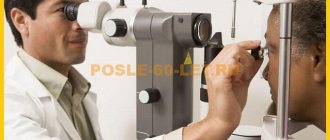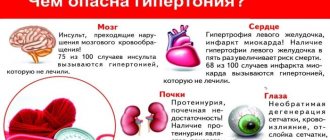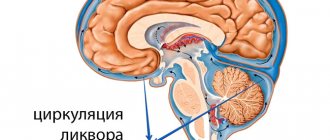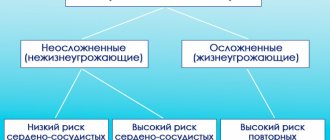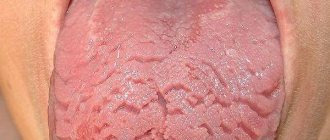Not every person knows that they need to regularly measure their blood pressure. At least so that when his blood pressure is 100 over 80 and his pulse is 100 beats per minute, he doesn’t take pills for headaches.
They may not help, and the general condition of the body is unlikely to return to normal. until the pressure returns to normal.
But it's not that simple. There are people for whom such indicators are the norm.
Symptoms
Symptoms of pressure 100 to 80 are varied. Their presence at these indicators is not necessary; as a rule, signs appear at lower values. General signs:
- fatigue;
- drowsiness;
- weakness;
- headache;
- pallor;
- circles under the eyes;
- heartbeat;
- cold extremities;
- slower reaction;
- impaired concentration.
Symptoms depending on the severity of hypotension:
- With milder hypotension, the first symptom is headaches; this may cause dizziness.
- With severe hypotension, a person not only feels dizzy and has a headache, but also feels lightheaded.
- In extreme cases, blurred vision, cold sweat on the forehead, severe nausea, and short-term unconsciousness occur.
Important! When pressure drops, the body's compensatory mechanisms are activated - to ensure good blood circulation to vital organs, the body tries to regulate hypotension by increasing heart rate, slowing down peristalsis, and reducing urine excretion. .
What to do
There is no need to worry if the patient:
- feels satisfactory;
- does not feel anxiety, weakness, fatigue, nausea, dizziness, headache;
- makes no other complaints.
If the opposite is true, you need to:
- Place the person on their back with their legs elevated. This increases blood flow to the brain, which avoids adverse consequences.
- Give access to fresh air. For this purpose, you can open a window.
- Drink sweet tea or coffee. These drinks help increase vascular tone, which increases blood pressure.
- Eat any sweets as an additional source of glucose.
- Use herbal preparations based on lemongrass, eleutherococcus, and ginseng. They have a general strengthening and tonic effect and help normalize blood pressure.
- Take a contrast shower, which also has a beneficial effect on vascular tone.
And also read on our website what to do if your blood pressure is: 100 over 50, 100 over 70, 100 over 90 and?
If the pressure of 100/80 is accompanied by the symptoms mentioned earlier and disrupts the usual way of life, then you should consult a specialist. Doctors usually prescribe:
- caffeine-based medicines;
- drugs that stimulate the nervous system;
- herbal medicines;
- complexes of vitamins, minerals and trace elements.
The doctor must conduct a survey, finding out:
- severity of symptoms, their duration;
- pre-existing conditions that could cause a decrease in blood pressure levels;
- the presence of chronic diseases that may be the basis of this condition;
- aspects of lifestyle, presence of bad habits;
- presence of pregnancy.
If your blood pressure is 100 over 80, this is a hypotensive condition for you, then you should remember that you need to consult a doctor, as there may be a risk of serious consequences. These include:
- chronic cerebrovascular accident;
- ischemia of the heart muscle;
- myocardial necrosis resulting from trophic disorders;
- fainting conditions;
- anemia.
To avoid hypotension you should:
- Normalize your daily routine. It is important not only to work, but also to fully rest. This allows the body to gain strength.
- Maintain a sleep schedule. To replenish energy, the body requires sleep, which should last at least 8 hours.
- Balance your diet. Eating rationally in small portions at least 5 times a day will help keep the body in good shape.
- Remember about physical activity. Movement is life. By leading an active lifestyle, you can avoid many dangerous diseases.
- Spend more time outdoors.
- To refuse from bad habits.
- Reduce the number of stressful situations.
Physiological hypotension
In absolutely healthy people, blood pressure may drop below normal, but they will not feel unwell. This could be hypotension:
- increased training in athletes;
- adaptive (detected in residents of high mountains, subtropics, tropics);
- individual version of the norm.
Physiological hypotension is diagnosed according to the following criteria:
- The patient has no complaints and feels well throughout the day.
- The examination revealed no pathologies.
- Low blood pressure is associated with intense training, living in high mountains or in hot climates.
- Age 16-20 years.
- Normal electrocardiogram. Slight bradycardia without pulse lability is detected.
- Prolonged standing is tolerated normally.
Patients who have physiological hypotension do not require treatment. But most often, a decrease in blood pressure still indicates pathology. Therefore, if your blood pressure is below normal, it is best to consult a doctor.
What does pulse pressure mean?
Increased pulse pressure is often observed in people suffering from hypotension. This may indicate vascular disease and ischemic disease, more often tachycardia. It can be calculated by subtracting the “lower” pressure from the “upper” pressure reading. That is, with a blood pressure reading of 100/80, it is 20 beats per minute. But what if the pulse is 100 beats per minute?
To normalize your heart rate, stop activity and relax. Try to breathe deeply and calmly, unfasten tight clothing, and wash with cold water. Take valerian, if there are no contraindications or intolerances to it, open the window to let fresh air in. If your pulse does not return to normal, seek medical help and call an ambulance at home.
Nutrition
An old person prone to low blood pressure is recommended to adhere to a dietary diet. The entire daily amount of food should be divided into 4-5 times. It is not recommended to overeat. If you feel hungry between meals, you can have a light snack: an apple, nuts, yogurt. Monitor the amount of fluid you drink. To maintain health, an adult needs to drink 2 liters of clean water daily.
Limit your salt intake. There is no need to exclude it completely. Think over your diet so that it includes a maximum of healthy foods rich in vitamins and minerals. In the network of boarding houses “Zabota”, each patient is given an individual diet that meets his needs. We monitor the patient's condition and are always there when necessary.
What does a high or low heart rate indicate?
Not much. Heart rate and blood pressure monitor levels are not related. Although the correlation is obvious, it does not exist.
However, the pulse can be used to assess the danger of the process, the need for hospital treatment and the prospects for recovery.
Sinus-type tachycardia (90-100 beats or more while maintaining the correct rhythm and intensifying the work of the natural driver) requires correction of the underlying disease. The acceleration of cardiac activity in itself does not pose a danger.
The paroxysmal type of tachycardia (paroxysmal) is associated with the threat of cardiac arrest and sudden death.
Fibrillation, fluttering, as well as group extrasystoles such as bigeminy and trigeminy, which are recorded during the ECG, provoke a fatal result even more often.
Bradycardia, that is, a decrease in heart rate of less than 60 beats per minute indicates a violation of tissue conductivity or a weakening of myocardial contractility. The prognosis is getting worse.
This is an indirect connection, mostly noted as a result of organic disorders of the heart and blood vessels.
Symptoms that require you to see a doctor
The list of manifestations can be presented as follows:
- Headache of any degree and nature.
- Dizziness, especially regular dizziness that does not go away on its own.
- Changes in heart rate such as acceleration or deceleration (both conditions are dangerous).
- Weakness, drowsiness, lack of desire to work or do anything.
- Nausea.
- Vomiting without signs of relief, often repeated.
- Heaviness in the legs.
- Chest pain for no apparent reason. Accompanied by severe arrhythmias.
- Irritability.
- Sharp darkening of the eyes when moving.
- Tinnitus, hearing loss.
- Changes in the nature of potency in men. Possible decrease in libido. Hypotension is associated with an increased risk of erectile dysfunction.
- Menstrual cycle disorders such as delay.
- Fainting, syncope.
- Paresthesia, paralysis, speech, vision and hearing disorders are possible. These are the most dangerous manifestations. Shortness of breath or suffocation.
Attention:
In all cases, you should consult a doctor or call an ambulance. The consequences can be unpredictable. It's not worth risking your health.
What does pressure 10080 mean?
Detection of low blood pressure may indicate the following:
- the person is hypotensive;
- an acute attack of hypotension developed;
- when systolic pressure is below 90 – the patient is in a state of shock, there is a violation of microcirculation and tissue metabolism.
Reduced numbers are also detected in children under the age of 16–17 years, which is a physiological condition and is not life-threatening.
The diagnosis of hypotension is established based on repeated measurements of the patient's blood pressure on different days and times of day. In the absence of complaints and pathological symptoms, a person can live a full life without treatment.
Acute attacks of hypotension occur in various conditions, such as:
- injuries to the brain or medulla oblongata;
- metabolic disorders (diabetes mellitus, ketoacidotic coma);
- contusion of the heart muscle;
- pericardial hemotamponade and others.
A chronic physiological decrease in blood pressure is a characteristic feature of tall people with low body weight (asthenics). Their peculiarity is the frequent presence of connective tissue diseases, decreased body reactivity, and a tendency to motion sickness.
What is pressure, what is its norm
Based on blood pressure (BP) indicators, a person’s health status is judged. During the measurement process, a tonometer is used to determine the force of pressure on the walls of blood vessels, which is pushed out of the organ cavity by the heart muscle. The concept of measurement is based on obtaining two digital values, the difference between which also has a certain meaning.
| Indicator name | What does the value indicate? |
| Systolic | The number corresponds to the pressure inside the arteries at the moment the heart is compressed and blood is pushed into their cavity at the systole stage. The value called upper blood pressure is recorded first when recording the results on paper. This indicator always exceeds the next (diastolic) value. |
| Diastolic | The number corresponds to the pressure force of the blood flow at the moment the heart muscle enters the relaxation phase. This is the minimum indicator of pressure in the arteries, reflecting the degree of stability of the blood vessels (peripheral). The value is written second after the upper blood pressure digit. |
| Pulse difference | The value, which is the mathematical difference between the upper and lower values, is usually not recorded on paper, but its figure is taken into account. It should be within 30-40 units, measured in mm of mercury, like the pressure itself. |
The level of blood pressure in a healthy person is relatively stable, but is subject to fluctuations under the influence of events in everyday life. The dynamics of changing values can be called a hint about the onset of pathological changes in the functioning of the heart and the condition of blood vessels.
Important: A pressure of 100 to 80 means that insufficient blood circulation has caused oxygen starvation of the heart muscle. This is manifested by too small a difference between the systolic and diastolic components of blood pressure, which may be a signal of the development of hypotension
What numbers correspond to the norm?
For each person, the concept of normal blood pressure values is purely individual, based on the state of health and characteristics of the body. The norm for the average person, not burdened with serious pathologies, is considered to be a blood pressure of 120/80.
There is no consensus among doctors regarding the pulse difference - some experts consider it a serious aspect, others have doubts about the importance of the figure. In the process of medical practice, doctors discovered a certain pattern:
- in the working population, the difference between blood pressure values can be 20-60 mm Hg. Art. both with values of 100/80 and with values of 120/60;
- in older people susceptible to hypertension, fluctuations in the difference signal an impending catastrophe of a vascular, cerebral or cardiac scale.
To obtain reliable information about your blood pressure level, you must measure it correctly. Measurements should be taken daily, at approximately the same time of day. An hour before the measurement, do not drink invigorating drinks (coffee, alcohol), as well as certain types of medications, and stop smoking. The measurement is performed twice with an interval of 2-3 minutes, sitting quietly without tension.
The effect of age on blood pressure
Continuing the study, taking into account the above information, we will try to establish: is the above blood pressure value - 100/80 - the norm?
Blood pressure largely depends on age. So, let's look at blood pressure standards by age. In infancy, for example, for one-year-old babies 96/66 is the norm, also the norm for men from 40-49 years old is 135/83, and for old people 80 years of age and above, their own norm is 147/82. For women, these figures are slightly lower - by 5-10 units. During pregnancy, blood pressure is often elevated. It changes several times during the day. Its indicator depends on many factors:
- One-time physical activity and sports lead to increased blood pressure.
- Taking medications can lead to both an increase and a decrease.
- Time of day - at night blood pressure is lower.
- Taking stimulants, such as alcohol, tea, coffee - an increase followed by a sharp decrease.
- Psychological state: stress provokes surges in blood pressure.
It is noteworthy that one-time maximum loads usually lead to an increase in blood pressure, and with stable high physical activity, when the body gradually adapts to it, blood pressure normalizes and even decreases slightly.
Blood pressure 100/80 - in pregnant women, elderly people (usually a consequence of high cholesterol), in men (their norm is usually higher than in women) - can be considered a sign of hypotension or, more correctly, hypotension. True, initial level. Arterial hypotension (hypotension) is a concept meaning low blood pressure. This is a “beacon”: the tone of blood vessels and muscles is reduced.
Why might blood pressure drop?
A value of 100 to 80 is not considered normal, but predicting serious pathologies only based on blood pressure and pulse differences is unacceptable. To understand the cause of this condition, you will have to monitor your blood pressure over time, not forgetting to measure your pulse along with your blood pressure. In addition, biochemical blood testing is important.
Low blood pressure in a healthy person
100/80 is not considered a characteristic sign of hypotension, but if a pressure of 120-125 over 80-85 is considered normal for a patient, it is worth thinking about the reasons for the appearance of low numbers. The presence of episodic fluctuations in blood pressure can be explained by external influences; if the drop in the indicator becomes regular, you should look for possible health problems associated with other reasons:
- extensive blood loss, symptoms of dehydration;
- consequence of the development of vegetative-vascular dystonia;
- signs of abnormal heart valve function;
- lack of adrenal and thyroid hormones;
- the development of thromboembolism as a result of heat stroke.
Deviation of pressure from the norm in the downward direction is more often found in adolescents and the elderly. In women during pregnancy, it is subject to fluctuations; a decrease to a level of 100 to 80 may indicate hormonal changes, the development of heart or kidney pathology. But it is not recommended for pregnant women to take medications that increase blood pressure on their own, so as not to harm the fetus.
Blood pressure indicators in preschool children are at the level of 95/60 mmHg. Art., which is considered normal, and their increase to 100 units by 80 already borders on a sign of the onset of hypertension. Men are characterized by higher units, which may fall due to an overdose of drugs for hypertension, in case of problems with heart function.
A table of pressure indicators for a relatively healthy person is given below.
Important: A small pulse difference is especially dangerous, which can signal a weak heart and an increased risk of a heart attack. No treatment is given for physiologically low blood pressure
100 to 80 in hypertensive patients
If, during the treatment of hypertension, a patient’s blood pressure drops to one hundred units, this is a signal that it is necessary to adjust the list of drugs used to treat hypertension. Also, the cause of a drop in blood pressure may be associated with the following factors:
- post-stroke period, in this case it is important to monitor the pulse, it may increase;
- overdose of antihypertensive drugs used to reduce high blood pressure units;
- increased physical activity of a hypertensive patient who is unaware of his pathology.
In hypertension, low blood pressure is often recorded during waking hours, which is manifested by a sudden loss of balance due to dizziness. A person may even lose consciousness due to such a jump. If you have a similar symptom without measuring your blood pressure, you should not immediately take a pill that lowers it, this will only worsen the condition.
100 to 80 and high pulse
The pulse reflects the heart rate; 80 beats per minute is considered normal. If, with low pressure, the pulse rises to 100 beats or higher, this is a possible onset of tachycardia, which accompanies psychosomatic disorders. A drop in blood pressure with an increase in heart rate can be observed in men who are professionally involved in sports, as well as under stress or taking antidepressants.
Please note: Tachycardia when the pressure drops to 100 to 80 can result in shock due to a deterioration in the ability of the cardiovascular system to get rid of carbon dioxide and metabolic products. This condition poses a threat of death
Reasons for small PD
Factors in the development of low pulse pressure are always pathological. They can be either cardiac or extracardiac. The former, however, are somewhat more common.
Sample list:
Renal pathologies
They are diverse. Dozens of diagnoses can be identified. To get an approximate idea, it is recommended to refer to the international classifier (ICD-10), which reflects the situation.
The reason is always the same. A sharp increase in prehormone-renin. Metabolites of this substance have vascular activity, causing narrowing (stenosis) of blood supply structures.
Large arteries cease to provide tissues with an adequate amount of oxygen and nutritional compounds. In this case, the heart is forced to work more actively due to increased resistance to the flow.
Hence the gradual increase in symptoms. An avalanche-like development of the clinical picture is possible.
Inflammatory pathologies of cardiac structures
Myocarditis, endocarditis, pericarditis primarily. Caused by infectious agents: herpes viruses, others, staphylococci, other pyogenic flora, fungi.
They lead to relatively rapid destruction of the atria with questionable prognoses for recovery.
Urgent treatment. In the hospital. Antiviral antibiotics are used. Fungicides and other medicines. If necessary, prosthetics are prescribed (a last resort).
Reduced pulse pressure is temporary. After a qualitative restoration of the state of health, everything returns to normal.
Congenital and acquired heart and vascular defects
Accompanied by organ dysfunction of varying severity. There are not always symptoms; sometimes diagnosis takes place right on the operating table, at the time of autopsy. Treatment is surgical, carried out in extreme cases.
Aortic valve defects
Usually presented with stenosis. Adequate blood flow into the systemic circle decreases, which leads to generalized problems and hypoxia on the one hand, and on the other hand, there is stagnation of liquid connective tissue in the chambers of the heart.
Hence dilatation (expansion), the development of insufficiency of the muscular organ.
Recovery is indicated again in a hospital, using surgical methods. As necessary, medications are prescribed to relieve symptoms.
Anemia
A sharp drop in hemoglobin levels in the blood. Presented in several clinical forms.
Megaloblastic is associated with vitamin B12 deficiency, iron deficiency - with insufficient concentration of Fe compounds, etc. the first is considered the most dangerous because it provokes hematopoietic disorders.
Both forms are accompanied by a group of symptoms, including changes in the condition of the skin, hair, nails, and a drop in blood pressure (an option with numbers of 100 to 80 or so is possible).
The patient's gastronomic preferences are distorted. The patient can eat chalk, limestone, and other objects.
Treating the condition is relatively simple. Compensation is carried out through iron supplements and vitamins.
It is also possible to eliminate chronic erosive sources leading to blood loss.
Dysregulation of nervous activity
Usually within the framework of special syndromes. A drop in pulse pressure is considered a manifestation of a complex known as vegetative-vascular dystonia.
This is not an independent diagnosis. Ascertaining the condition is not very difficult.
Treatment is not very successful; more often, temporary relief of symptoms is carried out, without the possibility of cardially influencing the situation. In such a situation, lifelong maintenance therapy is indicated.
A drop in pulse pressure is observed during so-called crises. They occur with different frequencies. During exacerbations, up to several times a week.
Arrhythmias
Unofficially in medical practice they are divided into dangerous and non-threatening to the patient’s condition. Such a classification is conditional, since simple forms often turn into complicated ones.
Recovery is carried out in a hospital. Then continued treatment in an outpatient clinic is indicated. A radical technique may be required, depending on the cause.
A decrease in pulse pressure to a level of 20 mmHg or less is observed on an ongoing basis. And it doesn’t matter what the tonometer shows. The proportional level is always the same.
Previous stroke
In character it resembles damage to cardiac structures, but has more pronounced features.
In almost 80% of cases, if not more, they are associated with the development of a neurological defect. From minor tics to complete muteness, blindness and other disabling conditions.
The rehabilitation period is accompanied by a decrease in pulse pressure; restoration of adequate blood pressure levels occurs spontaneously, after a certain time (from 3 months to six months).
There was no correlation between the general condition of the patient (neurological component) and the activity of cardiac structures.
Heart attack
A sharp disruption of myocardial nutrition and, as a consequence, tissue necrosis. It occurs quickly, the symptoms are as intense as possible, which makes the condition relatively simple to diagnose.
Some cases are associated with imminent death, especially extensive forms.
A drop in pulse pressure is a common consequence.
Contrary to the misconception, an acute condition is not always associated with an increase in blood pressure.
Recovery occurs in a hospital setting. PD is considered a qualitative indicator that is used to assess the dynamics of the rehabilitation process.
A stable decrease in level indicates the development of heart failure, which needs to be corrected.
A blood pressure of 100 over 80 is not normal. We are always talking about the development of a pathological process. What type - cardiologists find out.
Even a thorough and comprehensive examination does not guarantee detection. In the absence of data for organic conditions, they speak of the idiopathic form.
For your information:
The pressure drop has a characteristic feature. It recovers spontaneously when the underlying process is eliminated and does not tend to pathological stabilization, like hypertension.
Treatment regimen
Therapy is carried out from several positions and is designed to solve a group of problems.
Eliminating the root cause is the main point, since pressure of 100 to 80 is only a symptom. Here the field of activity is vast, everything depends on the patient’s condition and the underlying pathological process.
A few examples: anemia can be eliminated by the use of vitamins and iron; renal abnormalities require surgery or the prescription of medications, etc.
Symptomatic treatment consists of relief of manifestations. A number of pharmaceuticals are used to restore pulse pressure:
- Antihypertensive in combination with vascular tonic medications. The selection of the regimen is carried out with great care; disturbances in cardiac activity, myocardial contractility and other processes are likely.
- Antiarrhythmic. As needed. Amiodarone as the main one. In a strictly adjusted dosage, no more, to avoid dangerous side effects.
- Cardioprotectors.
- Diuretics are used less frequently.
Smoking and alcohol consumption are contraindicated throughout the treatment. Diet does not play a big role, all doubts are discussed with a nutritionist, and in the absence of the opportunity to consult with him, with a regular attending physician.
Diagnostics
Diagnostic measures to identify hypotension begin with interviewing the patient. A therapist or cardiologist will ask about changes in tonometer readings over a long period of time and ask about current symptoms and general well-being. Examines the patient and measures blood pressure. After this, the doctor may order several or all of the following tests:
- Cardiogram.
- Echocardiography.
- General blood analysis.
- Blood chemistry.
- Angiography.
- Radiography.
- Ultrasound of the heart.
- Daily blood pressure monitoring.
After establishing the causes of low blood pressure, the doctor will prescribe therapy.
Possible complications
Outside of therapy or with an insufficiently high-quality regimen, the following consequences may occur:
- Heart failure. As a result of a drop in output, blood stagnation and a decrease in myocardial contractility.
- Stroke. Acute malnutrition of cerebral structures. Potentially fatal condition.
- Heart attack. Necrosis of the muscle layer. Leads to deficiency, dysfunction and lifelong disability. The possibility of death always looms on the horizon.
- Cardiogenic shock. Carries the greatest danger. Even with timely assistance, no one guarantees the patient’s life. Statistics show that death occurs within 3-4 years, which happens less in almost 100% of people. The cause is a repeated episode of cardiac arrest or massive heart attack.
- Vascular dementia. As a result of constant disruption of nutrition of cerebral structures. Forms a clinical picture similar to that of Alzheimer's disease.
What does pressure 100 over 80 mean?
A score of 100/80 is not normal. Low upper pressure of 100 is a reason to be more attentive to your health and consult a doctor for further consultation. The systolic value is less than 90-100 mmHg. Art. often means a symptom of hypotension - low vascular tone. Indicators of 100 to 80 may be safe for young people in the absence of associated complaints. Low upper blood pressure in older people and poor health requires an immediate call to the ambulance.
The reason for low blood pressure of 100 to 80 is the insufficient power of the heart muscle to pump blood through large-diameter vessels. The first signs of a hypotensive state are headache and increased fatigue. Hypotension can be caused by the body’s adaptation to some new conditions or be a symptom of more serious diseases. In both cases, you should think about how to raise low blood pressure.
Frequent causes of physiological low blood pressure that do not require additional treatment are high physical activity in athletes and adaptation to a new climate. In pregnant women, hypotension is explained by the appearance of an additional circulatory system and changes in hormonal levels. Hypotension in pregnancy requires close monitoring because it jeopardizes the development of the baby.
Causes of hypotension caused by disruption of the normal functioning of the body:
- blood loss and dehydration, which reduce blood volume;
- deterioration of blood circulation due to atherosclerotic manifestations and vegetative-vascular dystonia;
- abnormal heart valve function;
- insufficiency of adrenal and thyroid hormones;
- thromboembolism;
- heatstroke.
Why is it dangerous?
Low blood pressure requires diagnosis because it can be a symptom of serious illness. Hypotension can be considered one of the symptoms of an impending heart attack. Consequences of insufficient oxygen supply to the body during hypotension:
- dizziness and loss of consciousness with risk of injury;
- memory impairment;
- weakened attention;
- decreased resistance to physical activity, general weakness;
- impaired coordination.
Features of essential hypotension
Primary hypotension occurs due to disruptions in the functioning of the vasomotor center and neuroendocrine regulation of vascular tone. It is characterized by:
- adynamia;
- loss of strength;
- headaches;
- memory disorder;
- increased physical and psycho-emotional fatigue;
- dizziness.
Hypotension often worsens at night. Blood pressure readings are below 50/35. To compensate for circulatory failure, the wakefulness center is activated, and the patient wakes up. Such awakenings lead to the patient not getting proper rest and feeling tired in the morning.
As a result of low blood pressure, the tone of all blood vessels decreases. This leads to the venous outflow in the brain being disrupted, which can lead to more than just headaches. Poor blood circulation in the brain leads to the fact that cells begin to die, and various cognitive disorders arise:
- memory and attention are impaired;
- there is a feeling of depression;
- anxiety increases.
Essential hypotension is also characterized by cardiac manifestations:
- heartache;
- congestive heart failure;
- absence of cardiomegaly.
Various factors contribute to the occurrence of primary hypotension:
- Heredity. Often such patients have an asthenic physique; they are thin but tall.
- Prolonged psycho-emotional stress.
- Prolonged mental work.
- Nasopharyngeal infectious diseases have a toxic effect on the hypothalamic-pituitary zone of the brain.
- Childhood malnutrition and infectious diseases.
- The influence of professional factors. Intense noise, overheating, and especially vibration cause an imbalance between the parasympathetic and sympathetic autonomic nervous systems.
- Exposure to radiation.
- Excessive physical activity.
Low blood pressure can occur due to other diseases.
Is it dangerous
To conclude whether pressure 105 over 65 is dangerous, you need to understand the reason for such indicators. There are two types of hypotension - primary and secondary. There are isolated cases of low blood pressure, as well as a physiological norm.
Primary hypotension
It is characteristic of neurotic ailments and occurs most often when people suffer from weather dependence and lead a sedentary lifestyle. Their performance remains at a normal level only in the first half of the day; later they are plagued by lethargy, apathy, and reluctance to do anything. This is not life-threatening, but it is advisable to take measures to increase blood pressure to improve your well-being.
Secondary hypotension
Develops in acute infectious diseases, blood loss (including internal bleeding), prolonged diarrhea, chronic infections and intoxications, as well as serious illnesses associated with immobility, nutritional disorders, and hypovitaminosis. In such cases, the cause of low pressure should be addressed.
Physiological norm
If we see low indicators, while feeling normal, then we are dealing with a physiological norm. This is clearly seen in the study of arterial parameters in adolescents and young people under 30 years of age. Only 5 percent of the subjects had low blood pressure, while a third of them did not reveal any disorders or abnormalities in their body.
If a temporary phenomenon
Sometimes hypotension is temporary and isolated, when a person is simply overheated in the sun and does not drink enough water. As a result of dehydration, the body compensates for the lack of fluid with blood, so the pressure drops sharply. Sunstroke and heatstroke are always accompanied by hypotension and these are very dangerous conditions for humans.
Rules for measuring blood pressure
How to prevent the situation from getting worse
When your blood pressure is 110 over 80, it is very important to make a few adjustments to your lifestyle. This will help improve the condition and prevent the progression of hypotension
Rules for living when blood pressure deviates from the norm:
- Active lifestyle. Play sports or get into the habit of walking in the evenings. This will significantly improve the condition of the body.
- Stop smoking. The results of this innovation will be noticeable almost immediately.
- Normalize your sleep. Sleep at least 8 and no more than 12 hours a day. It is also advisable to take a fifteen-minute rest every two hours of hard work.
- Maintain drinking regime. To calculate your fluid intake, you need to multiply your weight in kilograms by 30 ml.
- Avoid stress. Try not to get into conflict situations or create them.
- Eat right. Avoid fried, fatty and low-quality foods. Avoid drinking alcohol. Eat plenty of fresh vegetables, fruits and dairy products.
- Get rid of everything unnecessary. To improve your condition, you need to fight extra pounds. However, strict diets are prohibited. The best way to lose weight is proper nutrition and exercise.
A pressure of 100 over 80 is a non-critical indicator . Separately, such values of systole and diastole are within the normal range. However, due to low pulse pressure, such blood pressure has a negative impact on health and may be a symptom of problems within the body. Therefore, it requires consultation with a specialist.
Forecast
Determined by the underlying disease. 100 to 80 and even a drop in pulse pressure is not an indicator. The problem lies deeper. Negative consequences are associated with the following factors:
- Senile age.
- Cardiac abnormalities of a pronounced kind, organic defects, congenital and acquired defects.
- Pathologies of the excretory system.
- Bad habits.
- Negative family history.
- Severe general anamnesis.
- Poor response to treatment or complete lack thereof.
It is possible to say anything concrete after a long period of observation. The more diseases, the worse the outcome. The severity of the condition is also taken into account.


